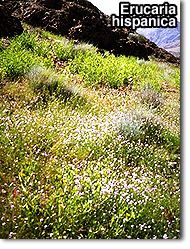 The higher slopes of the mountains must be climbed in order to see the plants that occur there. Hibiscus micranthus, aptly named for its 2 mm diameter flower, Euphorbia larica, Teucrium stocksianum and the Caralluma species, both the maroon fringed-petalled common one and the rare yellow Caralluma flava all occur here. I have my personal list of favourites from this cooler mountain habitat: firstly the popcorn plant with its unpronounceable name Pseudogaillonia hymenostephana - its tiny white trumpet flowers sit on velvety pink calyces, which start to become larger, whiter and papery thin with age, until the wind can blow these seed-carrying ballooons all over the place; secondly Blepharis ciliaris, the eyelash plant with its single blue petalled flower, the seeds of this plant remain with the mother plant until a heavy rainfall drenches the plant and hygroscopic mechanisms come into action to shoot the seeds over long distance away from their source; thirdly Asteriscus pygmaeus, a small yellow composite, that dries up into a tight woody bud, that shelters the seeds, drenched by a downpour (or by water from my waterbottle) the petals of this seedhead unfold and the seeds can drop out; and finally the 'Hand of Miriam' Anastatica hierochuntica , which folds up all its branches to form a clenched fist, that only unclenches to release the seeds during heavy rain. In spring, the relatively level plateaus between the mountains are carpeted with Erucaria hispanica, Diplotaxis harra and Asphodelus tenuifolius.
The higher slopes of the mountains must be climbed in order to see the plants that occur there. Hibiscus micranthus, aptly named for its 2 mm diameter flower, Euphorbia larica, Teucrium stocksianum and the Caralluma species, both the maroon fringed-petalled common one and the rare yellow Caralluma flava all occur here. I have my personal list of favourites from this cooler mountain habitat: firstly the popcorn plant with its unpronounceable name Pseudogaillonia hymenostephana - its tiny white trumpet flowers sit on velvety pink calyces, which start to become larger, whiter and papery thin with age, until the wind can blow these seed-carrying ballooons all over the place; secondly Blepharis ciliaris, the eyelash plant with its single blue petalled flower, the seeds of this plant remain with the mother plant until a heavy rainfall drenches the plant and hygroscopic mechanisms come into action to shoot the seeds over long distance away from their source; thirdly Asteriscus pygmaeus, a small yellow composite, that dries up into a tight woody bud, that shelters the seeds, drenched by a downpour (or by water from my waterbottle) the petals of this seedhead unfold and the seeds can drop out; and finally the 'Hand of Miriam' Anastatica hierochuntica , which folds up all its branches to form a clenched fist, that only unclenches to release the seeds during heavy rain. In spring, the relatively level plateaus between the mountains are carpeted with Erucaria hispanica, Diplotaxis harra and Asphodelus tenuifolius.
On the southward trip from Hatta to Al Ain the plant communities change continuously, even though the landscape seems to be more or less the same. Areas dominated by the very poisonous Iphiona aucheri give way to others where Fagonia indica and Pulicaria glutinosa reign supreme. Then follow stretches where the only perennial visible is the shrub Jaubertia aucheri. Further south Tephrosia apollinea is the main plant, with smaller stretches covered with Schweinfurthia papilloniacea and Rhazya stricta.
There is a story concerning Iphiona aucheri : When I arrived here in 1983, I took only pictures of plants. I was taught to take specimens after my first visit to Edinburgh botanical gardens. One of the photos that I showed in Edinburgh was of a stem with leaves and a seedhead of Iphiona aucheri, taken on Jebel Qatar near Al Ain. I never saw the plant again until 1990, when I noticed two lush shrubs along the Madam-Hatta road. At the time I wondered how two such large bushes could have escaped my attention earlier. I was even more amazed the next spring when just south of this location many dozens of bushes had sprung up. That spring several valuable racing camels died after browsing the succulent leaves. Analysis showed that the leaves contained powerful poisons, called sesquiterpenlactones ( Prof.U.Wernery, Central Veterinary Research Laboratorium Dubai). Orders were given for the plant to be destroyed, but this is an impossible task when it concerns a composite. Nowadays the first fifteen kilometres on either side of the road leading from Hatta to Mahda is permanently green with Iphiona foliage and the camels have learned to avoid it! The intriguing question is: what happened to this plant between 1983 and 1990, when I never found it during my weekly desert trips?

